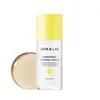What's inside
What's inside
 Key Ingredients
Key Ingredients

 Benefits
Benefits

 Concerns
Concerns

No concerns
 Ingredients Side-by-side
Ingredients Side-by-side

Water
Skin ConditioningDipropylene Glycol
HumectantCaffeine
Skin ConditioningGlycerin
HumectantNiacinamide
SmoothingGlycereth-26
Humectant1,2-Hexanediol
Skin ConditioningXanthan Gum
EmulsifyingC12-14 Pareth-12
EmulsifyingPolyglyceryl-10 Diisostearate
EmulsifyingHydroxyacetophenone
AntioxidantSodium Naphthalenesulfonate
C12-13 Pareth-9
EmulsifyingCaprylyl Glycol
EmollientAdenosine
Skin ConditioningDisodium EDTA
Hyaluronic Acid
HumectantDextrin
AbsorbentTheobroma Cacao Extract
Skin ConditioningPanthenol
Skin ConditioningButylene Glycol
HumectantEthylhexylglycerin
Skin ConditioningDipotassium Glycyrrhizate
HumectantResveratrol
AntioxidantWater, Dipropylene Glycol, Caffeine, Glycerin, Niacinamide, Glycereth-26, 1,2-Hexanediol, Xanthan Gum, C12-14 Pareth-12, Polyglyceryl-10 Diisostearate, Hydroxyacetophenone, Sodium Naphthalenesulfonate, C12-13 Pareth-9, Caprylyl Glycol, Adenosine, Disodium EDTA, Hyaluronic Acid, Dextrin, Theobroma Cacao Extract, Panthenol, Butylene Glycol, Ethylhexylglycerin, Dipotassium Glycyrrhizate, Resveratrol
Ingredients Explained
These ingredients are found in both products.
Ingredients higher up in an ingredient list are typically present in a larger amount.
Caffeine is most associated with coffee, tea, and cacao. In skincare, it helps with calming inflammation and is rich in antioxidants.
While caffeine is used to treat cellulite and and dark circles, further studies are needed to prove this. It has been believed to help with these skin conditions due to its ability to dilate blood vessels and increase blood flow.
Some studies are looking into caffeine's ability to protect against UV rays.
Learn more about CaffeineDipropylene Glycol is a synthetically created humectant, stabilizer, and solvent.
This ingredient helps:
Dipropylene glycol is technically an alcohol, but it belongs to the glycol family (often considered part of the ‘good’ alcohols). This means it is hydrating and gentle on skin unlike drying solvent alcohols like denatured alcohol.
As a masking agent, Dipropylene Glycol can be used to cover the smell of other ingredients. However, it does not have a scent.
Studies show Dipropylene Glycol is considered safe to use in skincare.
Learn more about Dipropylene GlycolDisodium EDTA plays a role in making products more stable by aiding other preservatives.
It is a chelating agent, meaning it neutralizes metal ions that may be found in a product.
Disodium EDTA is a salt of edetic acid and is found to be safe in cosmetic ingredients.
Learn more about Disodium EDTAGlycerin is already naturally found in your skin. It helps moisturize and protect your skin.
A study from 2016 found glycerin to be more effective as a humectant than AHAs and hyaluronic acid.
As a humectant, it helps the skin stay hydrated by pulling moisture to your skin. The low molecular weight of glycerin allows it to pull moisture into the deeper layers of your skin.
Hydrated skin improves your skin barrier; Your skin barrier helps protect against irritants and bacteria.
Glycerin has also been found to have antimicrobial and antiviral properties. Due to these properties, glycerin is often used in wound and burn treatments.
In cosmetics, glycerin is usually derived from plants such as soybean or palm. However, it can also be sourced from animals, such as tallow or animal fat.
This ingredient is organic, colorless, odorless, and non-toxic.
Glycerin is the name for this ingredient in American English. British English uses Glycerol/Glycerine.
Learn more about GlycerinNiacinamide is a multitasking form of vitamin B3 that strengthens the skin barrier, reduces pores and dark spots, regulates oil, and improves signs of aging.
And the best part? It's gentle and well-tolerated by most skin types, including sensitive and reactive skin.
You might have heard of "niacin flush", or the reddening of skin that causes itchiness. Niacinamide has not been found to cause this.
In very rare cases, some individuals may not be able to tolerate niacinamide at all or experience an allergic reaction to it.
If you are experiencing flaking, irritation, and dryness with this ingredient, be sure to double check all your products as this ingredient can be found in all categories of skincare.
When incorporating niacinamide into your routine, look out for concentration amounts. Typically, 5% niacinamide provides benefits such as fading dark spots. However, if you have sensitive skin, it is better to begin with a smaller concentration.
When you apply niacinamide to your skin, your body converts it into nicotinamide adenine dinucleotide (NAD). NAD is an essential coenzyme that is already found in your cells as "fuel" and powers countless biological processes.
In your skin, NAD helps repair cell damage, produce new healthy cells, support collagen production, strengthen the skin barrier, and fight environmental stressors (like UV and pollution).
Our natural NAD levels start to decline with age, leading to slower skin repair, visible aging, and a weaker skin barrier. By providing your skin niacinamide, you're recharging your skin's NAD levels. This leads to stronger, healthier, and younger looking skin.
Another name for vitamin B3 is nicotinamide. This vitamin is water-soluble and our bodies don't store it. We obtain Vitamin B3 from either food or skincare. Meat, fish, wheat, yeast, and leafy greens contain vitamin B3.
The type of niacinamide used in skincare is synthetically created.
Learn more about NiacinamideResveratrol is a famous emerging antioxidant. It is a good alternative for sensitive skin types who cannot tolerate retinoids.
This antioxidant is most famous for it's anti-aging benefits. Studies show it combats the signs of aging by:
Besides anti-aging, this ingredient also helps with skin brightening and soothing.
The most effective forms of resveratrol are isobutyrate and butyrate. These have the strongest effect on increasing A1 collagen and reducing inflammation.
A note on it being a retinoid alternative:
Despite it's amazing skin benefits, it is not a replacement for retinoids. However, it is recommended for people with sensitive skin or intolerance to retinoids.
Resveratrol is naturally found in grapes, peanuts, and berries.
Learn more about ResveratrolWater. It's the most common cosmetic ingredient of all. You'll usually see it at the top of ingredient lists, meaning that it makes up the largest part of the product.
So why is it so popular? Water most often acts as a solvent - this means that it helps dissolve other ingredients into the formulation.
You'll also recognize water as that liquid we all need to stay alive. If you see this, drink a glass of water. Stay hydrated!
Learn more about Water